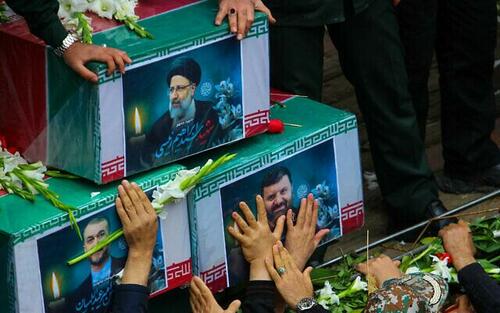Ayatollah Sets Presidential Election Date As High-Stakes Power Struggle Begins
Two days following the death of Iranian president Ebrahim Raisi and several of his top officials in a helicopter crash in the country’s northeast, Tehran has announced the date of presidential elections: June 28.
State-run IRNA announced an official election campaign window of June 12-27, followed by a day of national voting. Candidate registration is set to occur between May 30 and June 3. Raisi’s sudden death is expected to kick off a high-stakes power struggle while Shia clerical authorities are urging a smooth process.
Starting Monday the Islamic Republic’s Vice President Mohammad Mokhber was appointed as Interim President, while Iran’s nuclear negotiator, Ali Bagheri, was named acting foreign minister.
Tuesday marks the second of five days of national mourning, which will include a large Wednesday memorial ceremony in Tehran and overseen by Supreme Leader Ayatollah Ali Khamenei with foreign dignitaries present.
However the funeral for Raisi will be in Mashhad where the deceased president was born and raised. Iran’s second largest city, it is often called the “holiest city” in the country given its many religious pilgrimage sites.
As for the upcoming election at the end of June, which follows statements by Khamenei vowing that stability of leadership and government will not be interrupted, The New York Times has previewed:
Ayatollah Ali Khamenei, the country’s supreme leader, has two options, each carrying risks.
He could ensure that the presidential elections, which the Constitution mandates must happen within 50 days after Mr. Raisi’s death, are open to all, from hard-liners to reformists. But that risks a competitive election that could take the country in a direction he does not want.
Or he can repeat his strategy of recent elections, and block not only reformist rivals but even moderate, loyal opposition figures. That choice might leave him facing the embarrassment of even lower voter turnout, a move that would be interpreted as a stinging rebuke of his increasingly authoritarian state.
Of the question of turnout, the same report continues, “Voter turnout in Iran has been on a downward trajectory in the last several years. In 2016, more than 60 percent of the country’s voters participated in parliamentary elections.”
It notes that “By 2020, the figure was 42 percent. Officials had vowed that the result this March would be higher — instead it came in at just below 41 percent.”
The bodies of Ebrahim Raisi and his accompanying delegation in the helicopter crash are being transferred to Tehran so that they can be sent to Qom for the second leg of the five-city funeral procession.pic.twitter.com/F3BaFDeHPL
— Iran International English (@IranIntl_En) May 21, 2024
The Times has concluded that “Low turnout in recent years has been seen as a clear sign of the souring mood toward clerics and a political establishment that has become increasingly hard-line and conservative.” And Bloomberg has underscored, “Raisi was an ultraconservative cleric distrustful of the West.”
The investigation into the helicopter crash is ongoing, but authorities are rejecting any suggestion that it was an act of sabotage. Officials have emphasized the extreme weather conditions and citing likely technical failure over difficult mountainous terrain.
Tyler Durden
Tue, 05/21/2024 – 09:20

